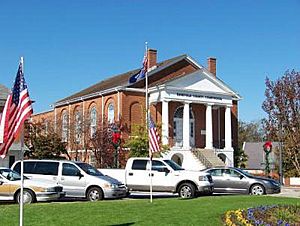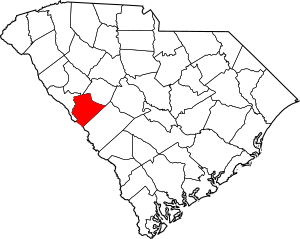Edgefield County, South Carolina facts for kids
Quick facts for kids
Edgefield County
|
||
|---|---|---|

Edgefield County Courthouse
|
||
|
||
| Nickname(s):
Home of Ten Governors
|
||
| Motto(s):
"It Feels Different Here Because It Is Different Here"
|
||

Location within the U.S. state of South Carolina
|
||
 South Carolina's location within the U.S. |
||
| Country | ||
| State | ||
| Founded | 1785 | |
| Named for | County's location at the Edge of the State | |
| Seat | Edgefield | |
| Largest community | Edgefield | |
| Area | ||
| • Total | 507.00 sq mi (1,313.1 km2) | |
| • Land | 500.71 sq mi (1,296.8 km2) | |
| • Water | 6.29 sq mi (16.3 km2) 1.24% | |
| Population
(2020)
|
||
| • Total | 25,657 | |
| • Estimate
(2023)
|
27,607 | |
| • Density | 51.24/sq mi (19.78/km2) | |
| Time zone | UTC−5 (Eastern) | |
| • Summer (DST) | UTC−4 (EDT) | |
| Congressional district | 3rd | |
Edgefield County is a county located in South Carolina, a state in the southeastern United States. It sits right on the western edge of the state. In 2020, about 25,657 people lived there. The main town and county seat (the center of county government) is Edgefield. The county was officially created on March 12, 1785.
The Savannah River forms part of Edgefield County's western border. Across this river is the city of Augusta, Georgia. Edgefield County is part of the larger Augusta-Richmond County, GA-SC Metropolitan Statistical Area.
Contents
Discovering Edgefield County's Past
The exact reason for the name "Edgefield" isn't fully known. Some think it's a creative name. There is also a village called Edgefield in England.
How Edgefield County Was Formed
Edgefield District was created in 1785. It was part of the larger Ninety-Six District. The state government decided to divide this big district into smaller areas. The Savannah River formed its western border. Over time, parts of Edgefield District were used to create other nearby counties. These include:
- Aiken County in 1871
- Saluda County in 1895
- Greenwood County in 1897
- McCormick County in 1916
Life in Early Edgefield County
Historians have studied the different groups of white people living in Edgefield County long ago. There were the poor, the middle-class farmers called yeomen, and the wealthy plantation owners. The plantation owners were clearly the richest. Yeomen farmers owned their own land and worked it themselves, often with the help of a few enslaved people. Wealthy plantation owners had many enslaved people and mostly managed their large farms.
Changes After the Civil War
After the Civil War, many formerly enslaved people in Edgefield County gained new rights. This led to big changes and disagreements. Some white groups tried to keep control and limit the voting rights of Black citizens. During elections, there were often conflicts and efforts to stop Black people from voting.
For example, in 1876, there was a serious event called the Hamburg incident. This involved a large group of armed white men and Black militia members. Later, during elections, more votes were counted for one political party than there were people living in the county. This showed that there was unfair voting. Eventually, federal troops who had been in South Carolina were removed in 1877. This marked the end of a period called Reconstruction.
Exploring Edgefield County's Geography
Edgefield County covers about 507 square miles. Most of this area, around 500 square miles, is land. The rest, about 6.3 square miles, is water.
Neighboring Counties
Edgefield County shares its borders with several other counties:
- Saluda County to the northeast
- Aiken County to the east
- Richmond County, Georgia to the southwest
- Columbia County, Georgia to the southwest
- McCormick County to the west
- Greenwood County to the northwest
Protected Natural Areas
Part of the Sumter National Forest is located within Edgefield County. This is a protected area of natural beauty.
People of Edgefield County
| Historical population | |||
|---|---|---|---|
| Census | Pop. | %± | |
| 1790 | 13,289 | — | |
| 1800 | 18,130 | 36.4% | |
| 1810 | 23,160 | 27.7% | |
| 1820 | 25,119 | 8.5% | |
| 1830 | 30,509 | 21.5% | |
| 1840 | 32,852 | 7.7% | |
| 1850 | 39,262 | 19.5% | |
| 1860 | 39,887 | 1.6% | |
| 1870 | 42,486 | 6.5% | |
| 1880 | 45,844 | 7.9% | |
| 1890 | 49,259 | 7.4% | |
| 1900 | 25,478 | −48.3% | |
| 1910 | 28,281 | 11.0% | |
| 1920 | 23,928 | −15.4% | |
| 1930 | 19,326 | −19.2% | |
| 1940 | 17,894 | −7.4% | |
| 1950 | 16,591 | −7.3% | |
| 1960 | 15,735 | −5.2% | |
| 1970 | 15,692 | −0.3% | |
| 1980 | 17,528 | 11.7% | |
| 1990 | 18,375 | 4.8% | |
| 2000 | 24,595 | 33.9% | |
| 2010 | 26,985 | 9.7% | |
| 2020 | 25,657 | −4.9% | |
| 2023 (est.) | 27,607 | 2.3% | |
| U.S. Decennial Census 1790–1960 1900–1990 1990–2000 2010 2020 |
|||
Population in 2020
In 2020, Edgefield County had 25,657 residents. There were 9,176 households and 6,471 families living there.
| Race | Num. | Perc. |
|---|---|---|
| White (non-Hispanic) | 104,890 | 58.03% |
| Black or African American (non-Hispanic) | 48,301 | 32.35% |
| Native American | 2,312 | 0.26% |
| Asian | 5,467 | 0.46% |
| Pacific Islander | 400 | 0.02% |
| Other/Mixed | 6,500 | 3.52% |
| Hispanic or Latino | 15,182 | 5.34% |
Population in 2010
In 2010, the county had 26,985 people. The population density was about 53.9 people per square mile. Most residents were white (58.6%), followed by Black or African American (37.2%). About 5.2% of the population was of Hispanic or Latino background. The average age of people in the county was 40.3 years old.
The average income for a household was about $42,834. For families, it was about $57,114.
Edgefield County's Economy
In 2022, the total value of all goods and services produced in Edgefield County was about $807.3 million. This is called the Gross Domestic Product (GDP). The unemployment rate in 2022-2023 was low, around 3.1-3.2%.
Some of the biggest employers in the county are Dollar General and the United States Department of Justice.
| Industry | Number of Jobs | Job Percentage (%) | Average Yearly Wage ($) |
|---|---|---|---|
| Hotels and Restaurants | 343 | 6.5 | 14,196 |
| Office Support and Waste Services | 222 | 4.2 | 46,800 |
| Farming, Forests, Fishing, and Hunting | 530 | 10.0 | 42,484 |
| Arts, Entertainment, and Fun | 52 | 1.0 | 24,492 |
| Building and Construction | 286 | 5.4 | 54,496 |
| Money and Insurance | 46 | 0.9 | 46,176 |
| Health Care and Social Help | 606 | 11.4 | 40,456 |
| Information Technology | 13 | 0.2 | 75,868 |
| Company Management | 8 | 0.2 | 104,988 |
| Manufacturing (Making Goods) | 1,419 | 26.8 | 56,940 |
| Other Services (not Government) | 237 | 4.5 | 52,676 |
| Science and Technical Services | 85 | 1.6 | 61,932 |
| Government Jobs | 794 | 15.0 | 65,468 |
| Real Estate and Rentals | 13 | 0.2 | 39,468 |
| Retail Stores | 362 | 6.8 | 43,680 |
| Transportation and Storage | 118 | 2.2 | 70,772 |
| Utilities (Power, Water) | 79 | 1.5 | 72,852 |
| Wholesale Trade | 87 | 1.6 | 86,060 |
| Total Jobs | 5,300 | 100.0% | 51,236 |
Media and News in Edgefield County
Edgefield County has its own local newspaper and radio station. It also receives television channels from nearby Augusta, Georgia.
Local Newspaper
- Edgefield Advertiser: This newspaper is published in the town of Edgefield. It is known for being the oldest newspaper in South Carolina.
Local Radio Station
- WLFW: This radio station is located in the town of Johnston.
Television Stations
Edgefield County is served by these television stations from Augusta, Georgia:
- WRDW-TV News 12
- WJBF NewsChannel 6
- WAGT NBC Augusta 26
- WFXG FOX-54
Communities in Edgefield County
Edgefield County has several towns and one city that is mostly in another county.
City
- North Augusta (most of this city is in Aiken County)
Towns
Census-Designated Place
Education in Edgefield County
All the public schools in Edgefield County are part of the Edgefield County School District.
Famous People from Edgefield County
Edgefield County is known for being the home of many important people. It's even nicknamed "Home of Ten Governors" because ten South Carolina governors came from here!
Governors from Edgefield County
- Andrew Pickens, II (1816–1818)
- George McDuffie (1834–1836)
- Pierce Mason Butler (1836–1838)
- James H. Hammond (1842–1844)
- Francis W. Pickens (1860–1862)
- Milledge L. Bonham (1862–1864)
- John C. Sheppard (1886)
- Benjamin R. Tillman (1890–1894)
- John Gary Evans (1894–1897)
- Strom Thurmond (1947–1951)
Other Notable People
Many other notable people have lived in Edgefield County, including:
- George Galphin (1709–1780)
- Samuel Hammond (1757–1842)
- Parson Mason Locke Weems (1759–1825)
- Rebecca "Becky" Cotton (1765–1807)
- Billy Porter (also known as “Billy the Fiddler”), an enslaved person (1771–1821)
- Rev. William Bullein Johnson (1782–1862)
- Augustus Baldwin Longstreet (1790–1870), a famous author
- Andrew Pickens Butler (1796–1857)
- Dave Drake (1800–1879?), an enslaved potter
- Francis Hugh Wardlaw (1800–1861)
- Louis T. Wigfall (1816–1874)
- Preston S. Brooks (1819–1857)
- General James A. Longstreet (1821–1904), a leading Confederate general
- Prince Rivers (1823–1887), a Black leader
- George D. Tillman (1826–1901)
- Martin Witherspoon Gary (1831–1881)
- Lucy Holcombe Pickens (1832–1899)
- Matthew Calbraith Butler (1836–1909)
- Alexander Bettis (1836–1895), a Black leader
- Lawrence Cain (1845–1884), a Black leader
- Paris Simkins (1849–1930), a Black leader
- Daniel Augustus Tompkins (1851–1914)
- Alfred W. Nicholson (1861–1945), a Black leader
- John William Thurmond (1862–1934)
- Emma Anderson Dunovant (1866–1956)
- Florence Adams Mims (1873–1951)
- Benjamin Mays (1894–1984), a Black leader and educator
- Francis Butler Simkins (1897–1966), a historian
Images for kids
See also
 In Spanish: Condado de Edgefield para niños
In Spanish: Condado de Edgefield para niños



